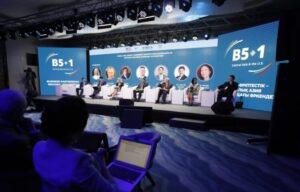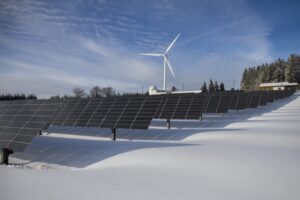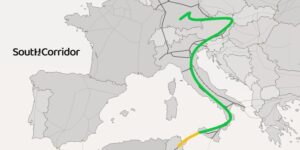- The OPEC cartel began as an alternative to the oligopoly of the largest oil companies in the West;
- Through production quotas, the organization is able to control the value of fuel in an artificial way on a global scale;
- Despite not having a defined leader country, Saudi Arabia in fact has the greatest decision-making power.
Oil is a fossil fuel considered a natural resource and the basis of the entire global energy matrix as it is the main source of energy today. Used in the main means of transport, in the operation of thermoelectric plants, in addition to the manufacture of various products, such as plastics, rubber and fertilizers.
With the Second Industrial Revolution in the 19th century, oil began to be widely used in transport and, in the 1970s, it represented around 50% of energy consumption in the world, making the oil market one of the most important in the world.
Being such a source of wealth, oil-producing countries have very strong negotiating power in global geopolitics. Because they are in practice a cartel that manages to control prices worldwide, the OPEC countries are the strongest in this regard.

What is the OPEC cartel, Organization of the Petroleum Exporting Countries?
The Organization of Petroleum Exporting Countries (OPEC) was founded in the 1960s, at the Baghdad Conference, in Iraq, under the narrative that they were against the supremacy of the “seven sisters”, the large Western oil companies, with the aim of, according to the organization’s own statutes:
Coordinate and unify oil policies among member countries in order to guarantee fair and stable prices for oil producers; an efficient, economical and regular supply of oil to consuming nations; and a fair return on capital for those who invest in the industry.
In this way, the members of the organization, as they have the largest oil production capacities on the international market, began to control the prices of barrels according to their economic and political interests.
Many critics of OPEC highlight the organization’s cartelized way of acting, controlling oil prices, its distribution and production, in addition to rigidly controlling the markets of member countries. Having a huge influence on global geopolitics.
This control with great geopolitical influence is confirmed when analyzing the High Oil Shocks, which caused very high inflation for countries that depended heavily on oil supplies and also increased the cost of energy and food for poorer countries.
The first shock occurred in 1973, when OPEC increased the price of barrels of fuel by more than 400%, making barrels cost, at the time, 12 dollars, which would be worth around 58 dollars today.
This was done as a form of repression and protest because the United States supported Israel in the Yom Kippur War, the war between Israel and Saudi Arabia, which is an illustrious member of OPEC, and caused a worldwide impact.
A political crisis in Iran in 1979 gave rise to the second shock, followed by a war between Iran and Iraq, where Iran, which is one of the world’s main producers, considerably reduced its production, causing the price to skyrocket to 120 dollars, if converted to current values, at the time, 34 dollars.
What are the countries that make up OPEC, Saudi Arabia as a leader in practice and what is OPEC+
Over more than six decades of history, several countries have been, and still are, part of OPEC. Initially, it was made up mainly of Middle Eastern countries. Currently, it is made up of 13 member countries, they are:
- Saudi Arabia: country located in the Middle East, has been a member of OPEC since the creation in 1960 and is its main leader in practice;
- Venezuela: since 1960, in South America and with the largest reserves outside the Middle East;
- Kuwait: also located in the Middle East, has been part of the summit since 1960;
- Iraq: has been part of the organization since 1960, its territory is located in the Middle East;
- Iran: since 1960, also located in the Middle East;
- Libya: located in North Africa, Libya joined OPEC in 1962;
- United Arab Emirates: since 1967, the UAE has also been part of the Middle East;
- Algeria: the country is in North Africa and joined OPEC in 1969;
- Nigeria: located in West Africa, the country has been part of the organization since 1971;
- Gabon: was a member between 1975 and 1995, returning to the organization in 2016. Gabon is part of Central Africa;
- Angola: the country joined the summit in 2007 and is part of southern Africa;
- Equatorial Guinea: joined OPEC in 2017 and is part of Central Africa;
- Democratic Republic of Congo: like Guinea and Gabon, Congo is located in Central Africa and joined OPEC in 2018.
Together, these 13 countries have oil reserves that make up around 73% of world reserves, according to 2016 data, and a production of almost 28 million barrels per day, according to a 2021 survey.
Furthermore, three countries were once part of OPEC, but are far away, because close to other member countries, their oil production is relatively low, meaning they have to submit to the decisions of others. Are they:
- Ecuador: South American country that joined OPEC in 1973 and withdrew in 1992, as it refused to pay an annual fee of US$2 million and wanted to produce more oil than OPEC allowed at the time. The country returned to the organization in 2007 and withdrew again in 2020;
- Indonesia: joined OPEC in 1962, but withdrew in 2008 when it was unable to meet its production quota. The country located in Southeast Asia returned in 2016, but only stayed until November, when the organization asked that 5% of the country’s production be cut;
- Qatar: The Middle Eastern country joined OPEC in 1961 and withdrew in 2019 to focus on natural gas production.
The Strength of Current OPEC+
In addition, there is also OPEC+, a union between OPEC members and oil exporting countries that are not part of the organization, with the aim of further aligning the interests of oil exporters.
oil flowers. Some examples of countries that are part of OPEC+ are Russia, Mexico, Malaysia, Kazakhstan and Sudan.
Nowadays, production quotas (oil supply on the world market) are much more controlled by OPEC+ than by the original OPEC. And consequently, it has been more effective in artificially maintaining high oil prices on the international market.
Russia’s invasion of Ukraine caused several countries, such as the United States and members of the European Union, to impose sanctions against Russia, causing the country to have to sell its fuel cheaper. However, some analysts consider that, even if the country increased the price, others would continue to import their oil due to their dependence on the fuel.
Another important thing already mentioned but worth highlighting is that, although OPEC does not have an official leading country, Saudi Arabia, which has the largest production and largest oil reserves among the members, in practice controls most of the decisions. of the organization.
There are also large oil producers in the world that are outside OPEC or OPEC+:
- United States: The country produces around 16 million barrels per day, more than OPEC’s largest producer, Saudi Arabia. Ademias, have 4% of all oil reserves in the world;
- Canada: Canada has the fourth largest oil basin in the world, considering countries inside and outside OPEC, which can total 168 billion barrels. In terms of production, it also occupies fourth position;
- China: With production of almost 4 million barrels per day, China ranks sixth among the largest oil producing countries. Its reserves have an exploration capacity of 26 billion barrels. However, it consumes much more than it produces, so it is the largest importer in the world;
- Brazil: Its proven reserves contain 15 times more oil than the annual consumption of the Brazilian population, making it the largest oil producer in South America, even though Venezuela has greater potential. On a global scale, it occupies ninth position in the ranking, producing 3 million barrels per day;
- Norway: Oil extraction in Norway is very efficient, meaning that, even though the country does not have the largest discovered reserves in the world, the country still has the capacity to produce 2 million barrels daily.
How OPEC controls fuel prices through production quotas
In a very simplistic summary, we can analyze that OPEC controls the price of its fuels through the basic concept of economics: the law of supply and demand to define prices (maintaining a constant cost).
However, in the classic concept of economic liberalism, the State would not interfere in the market, leaving the “invisible hand of the market” to define the prices of products in accordance with the law of supply and demand. OPEC breaks this concept by artificially controlling the supply of oil.
Because, as they act in a cartelized way, that is, each member country has a maximum production limit for a certain period of time, the organization is able to maintain control over how much they are producing as a whole, so that they do not produce too much and the price of fuel end up devaluing (increase in supply).
This is due to the fact that consumption is continuous and rarely changes (continuous demand). Production is inconstant and the more OPEC produces, the cheaper the fuel becomes on the world market. On the contrary, the less OPEC produces, the more expensive barrels of fuel become.
Of course, from country to country, the way the price of fuel is calculated will vary depending on the nation’s current situation. But on a global market scale, OPEC controls the general average price of the commodity, which can even cause inflation.
The geopolitical importance of OPEC in the supply of energy in a world with an energy matrix based on oil
In fact, fossil fuel is essential to a country’s economy and national security. All countries need energy to maintain themselves and oil remains the main raw material for much of industry and transport.
Due to this intrinsic need of each nation, OPEC maintains substantial power in global geopolitics, being able to control access and price of fuel according to its political interests, causing inflation and other deficits in the economies of other countries. This could result in greater influence of large oil-producing countries on the internal decisions of many oil-importing countries.
In other words, OPEC generates greater economic gains for its members, as well as a gain in geopolitical influence around the world.
However, even though oil still has its strength, more and more countries are trying to opt for electrical energy via cleaner sources, in order to create a sustainable energy matrix, something essential to maintain their independence in the global geopolitical scenario and take care of the climate. of the planet.
In this way, OPEC will eventually would lose its strength. Thus, the organization’s member countries have been diversifying their economies over the years, so as not to remain dependent solely on oil exports.
It is now time to wait and see whether this diversification will be successful in propelling OPEC members towards a future without oil, or whether the “petrostates” will weaken along with the weakening of the importance of oil in the world economy.











Be First to Comment